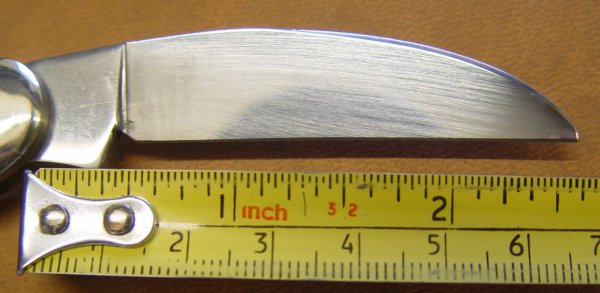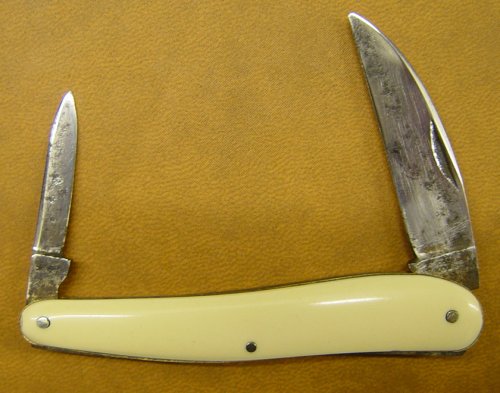Wharncliffe Bladed Knives
Wharncliffe Knives
Below: A Wharncliffe Whittler of 1852
The Wharncliffe blade is attributed to the design of Lord Wharncliffe who was the patron of Joseph Rodgers & Sons in Sheffield in the early 1800s. The blade was designed around 1832. To this time, most pocket knives had rather slender blades. Tradition has it that Lord Wharncliffe wanted a small pocket knife with a thick strong blade. The result was a knife that was not only a whittler pocket knife, but one that could be really leant on hard without danger of it breaking. A wood splitter. Once you have handled a knife with a real Wharncliffe blade, then you will appreciate the meaning of this. It is a beast of a blade, even though it may be quite short. The high arched back only adds to its strength.

There are many modern knives that have a Wharncliffe blade profile (or something close to it), and call themselves Wharncliffes, but to be a true Wharncliffe, it must be thick and strong. Compare the thickness of the master blade on this large Stockman with the Wharncliffe (below).

There are bastardisations of the name in common use today, such as "Warncliff", "Wharncliff" or even "Wharrencliff". No. It is a Wharncliffe.
Below, an early Joseph Rodgers (Sheffield) Wharncliffe bladed
knife.


Lord Wharncliffe
The Wharncliffe blade is attributed to the design of "Lord Wharncliffe" who was the patron of Joseph Rodgers & Sons in Sheffield. So I started doing a little research this evening into who he was....
The first Lord Wharncliffe was James Stuart-Wortley-Mackenzie (a triple barelled name) who lived in the village of Wortley 8 miles north-west of Sheffield (in the parish of Tankersley). He lived in the manor house there, which was built by Sir Thomas Wortley in 1510 as a summer house. The Wortley family just died out, with no male descendants, and James purchased the manor and at the same time changed his name to include the "Wortley" name. The house was originally named Wortley Hall, but later renamed "Wharncliffe Lodge". As late as 1822 it was still Wortley Hall, as shown in the Baines Directory of Yorkshire 1822, where James is listed as James Archibald Stuart Wortley Esq. M.P.
James Stuart-Wortley-Mackenzie became Lord Wharncliffe in 1826. This was the first time the title "Lord Wharncliffe" was used. He became Lord Privvy Seal in the administration of Sir Robert Peel (prime minister). (Peel was the person who founded the English police force, and police were commonly known as "Peelers" at the time). James married on 3 March 1799 to Elizabeth Caroline Mary, daughter of John Earl of Erne (of Ireland). The first Lord Wharncliffe (James) died in 1845, and his wife Elizabeth in 1856.
They has a son, who was (imaginatively) named James Stuart-Wortley-Mackenzie (the same as his father), and it is he who became the second Lord Wharncliffe. James also lived at Wharncliffe Lodge, near Sheffield. He also became a polititian, and at the time of his death in October 1855 he was a Member of Parliament and with the job of "Recorder of London". He owned various businesses including the Wharncliffe Brick and Tile Works at Wortley, and he also had interests in cotton, imported from the United States.
The third Lord Wharncliffe (his son) became Chairman of the Manchester, Sheffield & Lincolnshire Railway Company in 1874, and had a major part in the formation of the Great Central Railway Company in 1898 (which promptly absorbed the MS&LR). The third Lord Wharncliffe was a close friend of the artist Whistler.
So which Lord Wahrncliffe is attributed with the design of the "Wharncliffe" blade? - and was supposed to have been a patron of Joseph Rodgers & Sons? There was a company making pen and pocket knives in Sheffield in 1787 (recorded in the Gales & Martin Sheffield Directory), but this was "Joseph and Maurice Rodgers" of Norfolk Street, Sheffield. There were literally hundreds of companies making knives in Sheffield at that time. However, it is extremely unlikely that Lord Wharncliffe had them make his knife, as he was around 9 years old at the time. Furthermore, the "Wharncliffe" name was not in existence until 1826 when James became a Lord.
The 1822 Baines Directory turns up some interesting names in Sheffield - members of the same family as Lord Wharncliffe (Wortley):
Wortley, John & Son, merchants, factors and scissor manufacturers, 39
Trinity Street
Wortley, David. scissor manufacturer, 29 Gibraltar Street.
So the to-be Lord Wharncliffe had relatives in the business, not knife making, but scissors.
In the 1822 directory there are a whole host of Rodgers family members, each with businesses making knives, but the prominent one is: "Rodgers Joseph and Sons, (Cutlers to His Majesty) merchts. & mfrs. of table knives and forks, silver and plated desserts, pen and pocket knives, razors, and scissors, 7 Norfolk Street". It is hardly surprising therefore, that our to-be Lord Wharncliffe (still named Wortley) but a member of Parliament and with relatives in Sheffield at the time who were making scissors, would have some connections with the Rodgers & Sons company.
The only thing that we have established so far, however, is that the "Wharncliffe" blade cannot have been invented before 1826, as there was no "Wharncliffe" name until then, when James became a Lord Wharncliffe.
The first real reference I have found so far to the blade, is a near-perfect "copy" of the Wharncliffe bladed Case Seahorse Whittler in an Unwin & Rodgers illustrated advertisement in 1852.
